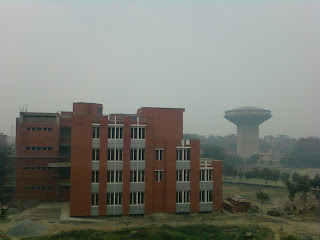Thursday, 12 May 2011
Wednesday, 11 May 2011
Guru Gobind Singh Indraprastha University (GGSIPU)
Guru Gobind Singh Indraprastha University is an affiliating and teaching University , established by Government of NCT of Delhi under the provisions of Guru Gobind Singh Indraprastha University Act, 1998 read with its Amendment in 1999.It is recognised by University Grants Commission, India under section 12B of UGC Act. Guru Gobind Singh Indraprastha University has been accredited "A Grade" by NAAC during Feb- March 2007. The University has been awarded the ISO 9001:2000 Certification by Standardization, Testing and Quality Certification Directorate, Department of Information Technology, Ministry of Communication and Information Technology, Government of India, for a period of three years . Functioning of the University commenced with the joining of Prof. K.K. Aggarwal as Vice-Chancellor in December, 1998. An emminent scholar and innovative person in Prof. K.K. Aggarwal, the first ViceChancellor of the University, proposes to develop the University into a centre of excellence comparable to the best in the world. The University is currently functioning from its Campus spread over an area of 16 acres at Kashmere Gate, Delhi. The University has taken possession of land measuring 60 acres at Dwarka (West Delhi) for setting up a State-of-Art Campus of the University with ultra-modern facilities. It has also been decided to establish another Campus of the University in East Delhi and land measuring 19 acres has been taken over opposite Surajmal Vihar, Karkardooma for this purpose. | ||
Within a short span of eight years, the University has been able to make its presence felt the world over. It is running more than 60 programmes in 08 University Schools of Studies and 86 Institutes (Government as well as self-financing), imparting professional education in various disciplines to more than 40,000 students with an annual intake of more than 12,000. The students of this University are getting excellent placements in best of the companies like, TCS, Infosys, Wipro, DCM Technologies, Mahendra British Telecom, Quark, ST Microelectronics, Ranbaxy, Pepsi, HDFC & ICICI Banks, Nestle, LG, Reliance and so on.The focus on research is evident from the publications/presentations of over 152 research papers during 2005-06, though the regular strength of professionally qualified faculty on the campus is about 149 teachers. The University in its functioning gets support and guidance from its Statutory Bodies such as the Court, the Board of Management, the Planning Board, the Board of Affiliation, the Academic Council and the Finance Committee. To facilitate the assigned role by these Statutory bodies, the members of these bodies are the persons of eminence from varied fields and disciplines. | ||
Tuesday, 10 May 2011
Albert Einstein
Albert Einstein; 14 March 1879 – 18 April 1955) was a German-born theoretical physicistwho developed the theory of general relativity, effecting a revolution in physics. For this achievement, Einstein is often regarded as the father ofmodern physics. He received the 1921 Nobel Prize in Physics "for his services to theoretical physics, and especially for his discovery of the law of the photoelectric effect". The latter was pivotal in establishing quantum theory within physics.
Near the beginning of his career, Einstein thought that Newtonian mechanics was no longer enough to reconcile the laws of classical mechanicswith the laws of the electromagnetic field. This led to the development of his special theory of relativity. He realized, however, that the principle of relativity could also be extended to gravitational fields, and with his subsequent theory of gravitation in 1916, he published a paper on the general theory of relativity. He continued to deal with problems of statistical mechanics and quantum theory, which led to his explanations of particle theory and the motion of molecules. He also investigated the thermal properties of light which laid the foundation of the photon theory of light. In 1917, Einstein applied the general theory of relativity to model the structure of the universe as a whole.
He was visiting the United States when Hitler came to power in 1933, and did not go back to Germany, where he had been a professor at theBerlin Academy of Sciences. He settled in the U.S., becoming a citizen in 1940. On the eve of World War II, he helped alert President Franklin D. Roosevelt that Germany might be developing an atomic weapon, and recommended that the U.S. begin similar research. Later, together with Bertrand Russell, Einstein signed the Russell–Einstein Manifesto, which highlighted the danger of nuclear weapons. Einstein taught physics at theInstitute for Advanced Study at Princeton, New Jersey, until his death in 1955.
Subscribe to:
Comments (Atom)

































